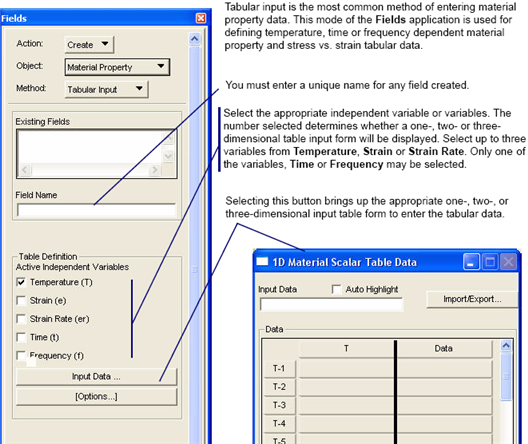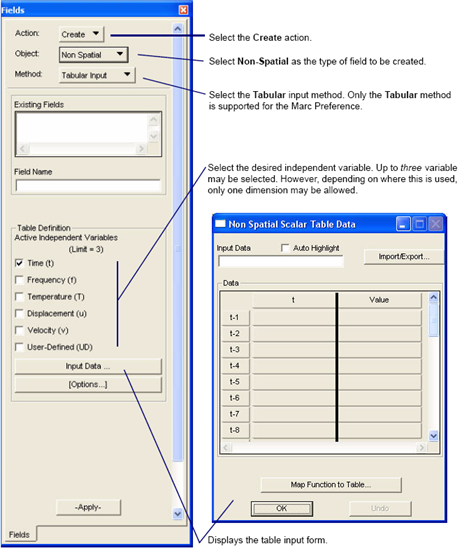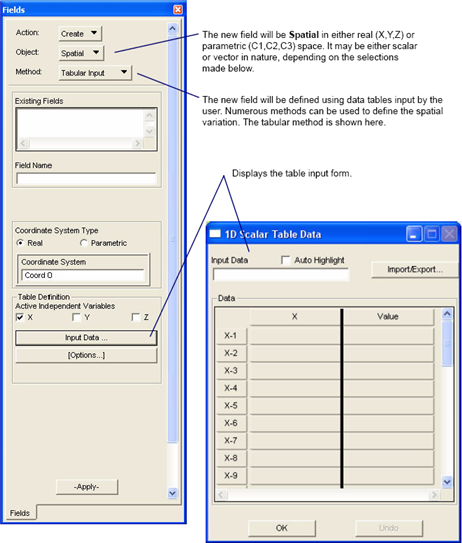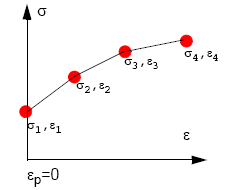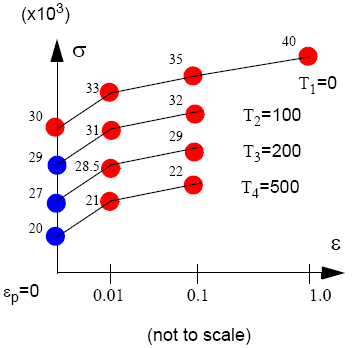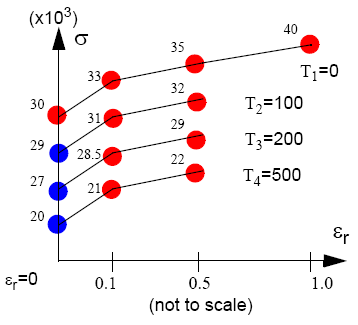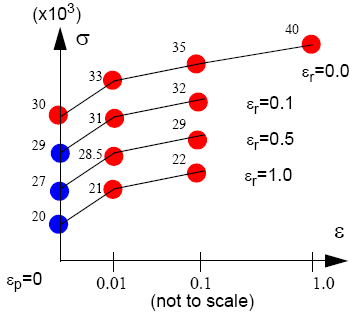XXXXXXXXXXXXXXXXXXXXXXXXXXXXXXXXXXXXXXXXXXXXXXXXXXXXXXXXXXXXXXXXXXXXXXXXXXXXXXXXXXXXXXXXXXXXXXXXXXXXXXXXXXXXXXXXXXXXXXXXXXXXXXXXXXXXXXXXXXXXXXXXXXXXXXXX''"> Fields - Tables
The Fields application is used to store tabular data that may be applied or associated with material or element properties, or loads and boundary conditions. The actual operation of the Fields application is described in
Fields Application (Ch. 1) in the Patran Reference Manual. A brief description is supplied here as it pertains to the Marc Preference.
There are three basic types of fields or tables which can be used to define properties and values:
• Material Fields - used primarily to define how a given material property varies with strain, strain rate, time, frequency, or temperature.
• Spatial Fields - used primarily to define how element properties vary over a surface, such as thickness, or the length of a beam, such as cross-sectional area. Also used to define how loads vary with physical location.
• Non-Spatial Fields - used primarily to define how loads and boundary conditions vary with time or frequency.
Fields Overview
Material property tabular data is entered with the Object set to Material Property. See
Material Fields.
Time and frequency varying information is entered with the Object set to Non-Spatial.
Spatially varying information is entered with the Object set to Spatial such as variation of thickness over a plate or of the load versus distance.
Material Fields
Some material properties can reference tabular data fields. The following is a brief explanation of what the Marc Preference does with these fields and how they get translated into the input file. This discussion for 2D and 3D data fields pertains to Marc version 2001 or earlier as these versions are incapable of dealing with fully populated 2D and 3D material fields through the standard input. For versions beyond 2001, fully populated data 1D, 2D, and 3D fields are translated verbatim to the input file using the TABLE option, thus obsoleting the following options: TEMPERATURE EFFECTS, ORTHO TEMP, STRAIN RATE, WORK HARD.
1D Fields
This is the simplest case where only a one dimensional field has been referenced. The Marc input file will simply contains the proper option of x versus y values:
Plastic Strain Fields
A referenced tabular field of plastic strain versus stress will create the WORK HARD option as such
WORK HARD, DATA
# of points, 0, MATID
s1, 0.0
s2, e2
s3, e3
s4, e4 <- data repeated <# of points> times
etc.
Note: | The stress value at zero plastic strain is entered as the yield stress in the ISOTROPIC, ORTHOTROPIC and ANISOTROPIC options. |
Note: | The first plastic strain value must be zero in which case the stress-strain curve is assumed to be true stress vs true strain (natural log of the plastic strain). If it is not zero, then it is assumed that engineering stress/strain has been entered and will be converted to true stress/strain as required by the solver. |
Temperature Fields
A referenced tabular field of temperature versus a material property value such as Yield Stress, Young’s Modulus or Poison’s Ratio will create the TEMPERATURE EFFECTS or ORTHO TEMP options as such:
TEMPERATURE EFFECTS or ORTHO TEMP, DATA
#1, #2, #3, #4, #5, #6, #7
s1, T1
s2, T2
s3, T3
s4, T4 <- data repeated #1 times
etc.
E1, T1
E2, T2 <- data repeated #2 times
etc.
etc. <- data repeated for each temperature dependent property
Note: | A Reference Temperature must be indicated on the Elastic constitutive model. The temperature curve at this temperature will be the reference temperature curve for writing strain hardening data on the WORK HARD option. |
Strain Rate Fields
A referenced tabular field of yield stress versus strain rate will create the STRAIN RATE option as such
STRAIN RATE, DATA
# of points, mat ID
s1, 0.0
s2, er2 <- data repeated (# of points) times
etc.
Note: | The first strain rate value must be zero. |
Time/Frequency Fields
These work in a very similar way and create either VISCELMOON, VISCELOGDEN, VISCELPROP, CREEP or PHI-COEFICIENTS options.
2D Fields
There are three scenarios for 2D material fields.
Temperature - Plastic Strain Fields
A field of this nature indicates that both WORK HARD and TEMPERATURE EFFECTS (or ORTHO TEMP) options are written. Marc 2000 (or earlier) is incapable of dealing with a fully populated 2D table. A 2D table of temperature and plastic strain versus yield stress indicates a different stress-strain curve for each different temperature referenced as shown in the graph.
The Patran tabular field might look like this (x103):
| T |
ep | | 0.0 | 0.01 | 0.1 | 1.0 |
| 0 | 30 | 33 | 35 | 40 |
100 | 29 | 31 | 32 | 33 |
200 | 27 | 28.5 | 29 | 30 |
500 | 20 | 21 | 22 | 25 |
But only the values in red (top row) are written to the WORK HARD option as the reference temperature curve, T1=0.
WORK HARD, DATA
4,
30000.,0.0
33000.,0.01
35000.,0.1
40000.,1.0
Note: | The yield stress at zero plastic strain is also written to the ISOTROPIC, ORTHOTROPIC, or ANISOTROPIC option. |
Only the values in blue (first column) are written to the TEMPERATURE EFFECTS (ORTHO TEMP) option to define the yield stress as a function of temperature. For temperature dependent hardening, what is written is the variation of slope with temperature divided by the slope of the reference curve (at T1=0 in this case) in the first region, i.e., between plastic strain of zero and 0.01:
TEMPERATURE EFFECTS, DATA
4, 0, 0, 0, 0, 4, 1
30000.,0.
29000.,100.
27000.,200.
20000.,500.
1.0 ,0.
0.6667,100.
0.5 ,200.
0.3333,500.
Note: | The first four points on the TEMPERATURE EFFECTS option denote the yield stress as a function of temperature at zero plastic strain. The last four points denote the work hardening versus temperature as a ratio of the slope in the first region  divided by the slope of the curve at the reference temperature: Slope at reference temperature: (33 - 30) / (0.01 - 0) = 300; 300/300 = 1.0 Slope at other points: (31 - 29) / 0.01 = 200; 200/300 = 0.6667
(28.5 - 27)/ 0.01= 150; 150/300 = 0.5
(21 - 20) / 0.01 = 100; 100/300=0.3333 |
Temperature - Strain Rate Fields
A field of this nature indicates that both STRAIN RATE and TEMPERATURE EFFECTS (or ORTHO TEMP) options are written. Marc 2000 (or earlier) is incapable of dealing with a fully populated 2D table. A 2D table of temperature and strain rate versus yield stress indicates a different stress/strain-rate curve for each different temperature referenced as shown in the graph.
The same table is used as in the previous example except strain is now strain rate (x103):
| T |
er | | 0.0 | 0.1 | 0.5 | 1.0 |
| 0 | 30 | 33 | 35 | 40 |
100 | 29 | 31 | 32 | 33 |
200 | 27 | 28.5 | 29 | 30 |
500 | 20 | 21 | 22 | 25 |
Only the values in red are written to the STRAIN RATE option (which are the values from the reference temperature curve).
STRAIN RATE, DATA
4,1
30000.,0.0
33000.,0.1
35000.,0.5
40000.,1.0
And only the values in blue are written to the TEMPERATURE EFFECTS (ORTHO TEMP) option. Again, the yield stress of the reference curve at zero strain rate is written to the ISOTROPIC, ORTHOTROPIC, or ANISOTROPIC options.
TEMPERATURE EFFECTS, DATA
4,0,0,0,0,0,1
30000.,0.0.
29000.,100.
27000.,200.
20000.,500.
Note: | The first four points on the TEMPERATURE EFFECTS option denote the yield stress change with temperature at zero strain rate. |
Plastic Strain - Strain Rate Fields
A field of this nature indicates that both STRAIN RATE and WORK HARD options are written. Marc 2000 (or earlier) is incapable of dealing with a fully populated 2D table. A 2D table of strain and strain rate versus yield stress indicates a different stress/strain-rate curve for each different strain referenced as shown in the graph.
The same table is used as in the first 2D example except temperature is now strain rate (x103):
| ep |
er | | 0.0 | 0.1 | 0.5 | 1.0 |
| 0.0 | 30 | 33 | 35 | 40 |
0.01 | 29 | 31 | 32 | 33 |
0.1 | 27 | 28.5 | 29 | 30 |
1.0 | 20 | 21 | 22 | 25 |
But only the values in red (at zero strain) can be written to the STRAIN RATE option and only the values in blue (at zero strain rate) can be written to the WORK HARD option:
STRAIN RATE, DATA
6, 1
30000.,0.0
33000.,0.1
35000.,0.5
40000.,1.0
WORK HARD, DATA
4, 0, 1
30000.,0.0
29000.,0.01
27000.,0.1
20000.,1.0
3D Fields
There is only one scenario for 3D fields.
Temperature - Plastic Strain - Strain Rate Fields
A field of this nature indicates that WORK HARD, STRAIN RATE and TEMPERATURE EFFECTS (or ORTHO TEMP) options are written. Marc 2000 (or earlier) is incapable of dealing with a fully populated 3D table. A 3D table of temperature, plastic strain, and strain rate versus yield stress indicates a different stress-strain curve for each different temperature referenced as shown in the graph plus another dimension as the strain rate changes.
The Patran tabular field might look like this (a combination of the above three 2D cases):
er=0.0 | | T |
| ep | | 0.0 | 0.01 | 0.1 | 1.0 |
| 0 | 30 | 33 | 35 | 40 |
100 | 29 | 31 | - | - |
200 | 27 | 28.5 | - | - |
500 | 20 | 21 | - | - |
er=0.1 | | T |
| ep | | 0.0 | 0.01 | 0.1 | 1.0 |
| 0 | 33 | - | - | - |
100 | - | - | - | - |
200 | - | - | - | - |
500 | - | - | - | - |
er=0.5 | | T |
| ep | | 0.0 | 0.01 | 0.1 | 1.0 |
| 0 | 35 | - | - | - |
| 100 | - | - | - | - |
| 200 | - | - | - | - |
| 500 | - | - | - | - |
er=1.0 | | T |
| ep | | 0.0 | 0.01 | 0.1 | 1.0 |
| 0 | 40 | - | - | - |
| 100 | - | - | - | - |
| 200 | - | - | - | - |
| 500 | - | - | - | - |
Values not written to the input file have been intentionally left out of the above tables to illustrate what is actually written. Only the values in red (first row of first table) are written to the WORK HARD option. See the explanation under
2D Fields.
WORK HARD, DATA
4,
30000.,0.0
33000.,0.01
35000.,0.1
40000.,1.0
Only the values in blue (first column of first table) are written to the TEMPERATURE EFFECTS (ORTHO TEMP) option for yield stress versus temperature and the change in slope for work hardening versus temperature. Again, this is explained in
2D Fields.
TEMPERATURE EFFECTS, DATA
4, 0, 0, 0, 0, 4, 1
30000.,0.
29000.,100.
27000.,200.
20000.,500.
1.0 ,0.
0.6667,100.
0.5 ,200.
0.3333,500.
Only the values in green (values of strain rate at zero strain at the reference temperature) are written to the STRAIN RATE option.
STRAIN RATE, DATA
4, 1
30000.,0.0
33000.,0.1
35000.,0.5
40000.,1.0
Spatial Fields
Some element properties and loading conditions can reference tabular data fields or fields defined by PCL functions. The following is a brief explanation of what the Marc Preference does with these fields and how they get translated into the input file.
codeindent10: Suppose you want to define a property, such as shell thickness, to vary over the surface of a 1x1 square flat plate such that at (0,0) thickness is 1.0 and (1,1), thickness is 2.0. Thicknesses in between these coordinates will be linearly interpolated. You could define a table such as:
| X |
Y | | 0.0 | 1.0 |
| 0.0 | 0.0 | 1.5 |
| 1.0 | 1.5 | 2.0 |
Or you could define a PCL function to accomplish the same thing such as:
0.5*(‘X+1) + 0.5*(‘Y+1)
The values at each element centroid or nodal point, depending on what is requested, will be evaluated and written accordingly to the Marc input file.
The above example could be used to also vary the pressure across the plate. A pressure loading referencing this spatial field could be applied with an appropriate scale factor to scale it to the proper loading value. Or you could create a new table or PCL function with the scaling already accommodated.
Non-Spatial Fields
These fields or tables are typically used with loading conditions that need to vary over time or frequency. Only tabular fields are supported with one or two active independent variables, those being either time or frequency and velocity or displacement. The following is a brief explanation of what the Marc Preference does with these fields and how they get translated into the input file.
As a brief explanation, suppose you wish to define a load that ramps from zero to one and then back down to zero over one second. A simple table as shown below can be created:
Time | Value |
0.0 | 0.0 |
0.5 | 1.0 |
1.0 | 0.0 |
This could represent a position controlled rigid body that moves one unit towards the deformable contact body in the first half second and then back to its original position in the second half second. Or it could represent a load that is scaled to its full value in the first half second and then taken back down to zero in the second half second.
What is written to the Marc depends on how the load stepping is set up under the Analysis application. If only one load step is created, the Marc input file might look something like this for motion control:
<parameter section>
END
<model section>
CONTACT <initial position set to zero>
END OPTION
MOTION CHANGE <position set to one unit>
TIME STEP
0.5
CONTINUE
MOTION CHANGE <position set back to zero>
TIME STEP
0.5
CONTINUE
or like this for a point loading:
<parameter section>
END
<model section>
POINT LOAD <initial load set to zero>
END OPTION
POINT LOAD <load scaled to maximum>
TIME STEP
0.5
CONTINUE
POINT LOAD <load set back to zero>
TIME STEP
0.5
CONTINUE
The job could also be broken up into two load steps within the Analysis application where the first load step covers the first half second and the second step covers the last half second. In this way, you can control the load incrementation and other control parameters that may need to be different for the first half second relative to the second half second. For example:
<parameter section>
END
<model section>
POINT LOAD <initial load set to zero>
END OPTION
AUTO LOAD
18
POINT LOAD <load scaled to maximum>
TIME STEP
0.5
CONTINUE
AUTO LOAD
24
POINT LOAD <load set back to zero>
TIME STEP
0.5
CONTINUE
An important point with non-spatial fields is for motion control of rigid bodies. When defining motion that varies with time or that split between two or more Load Steps, it is advantageous and sometime necessary to define the motion via a non-spatial field of motion (either velocity or displacement) versus time. This is done identically to the discussion above. However, with contact if you define a 1D field (one independent variable), the motion of all the components of the rigid body are defined by this field. You have no control over each component individually, including the angular position or velocity.
To control each component separately, you must define a 2D field of motion (velocity or position) versus time. In this case you select both time and displacement or velocity as the independent variables. You must then fill out a tabular two dimensional field. As an example let us say that a rigid body motion is to move in the y-direction for the first second and then in the x-direction for the 2nd second. You would define a field like this:
Time | x-comp | y-comp | z-comp | angular
comp. |
| 1.0 | 2.0 | 3.0 | 4.0 |
0.0 | 0.0 | 0.0 | 0.0 | 0.0 |
1.0 | 1.0 | 0.0 | 0.0 | 0.0 |
2.0 | 0.0 | 1.0 | 0.0 | 0.0 |
Note: | All four components must be defined. The values (1.0, 2.0, 3.0, 4.0) above each component column are arbitrary but must be in ascending value to define the field. |
Note: | Also, whenever possible, for Marc version 2003 and beyond, if a TABLE option can be written to define a field it will! |


